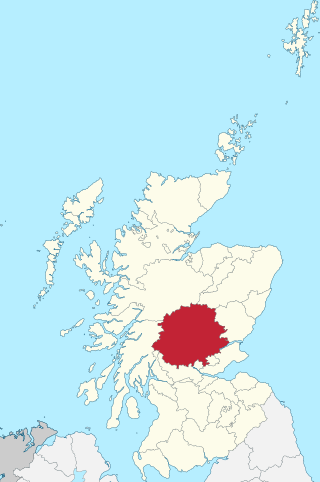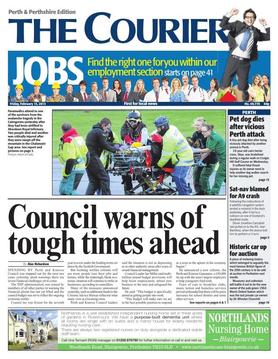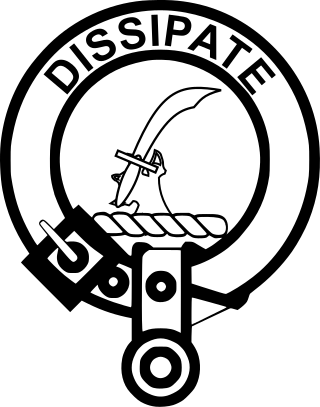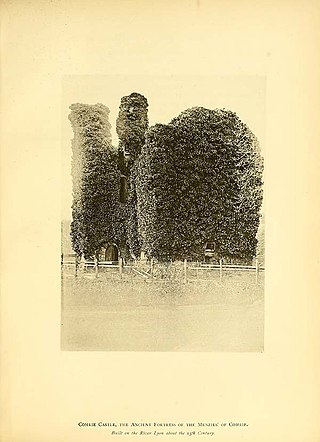
Perthshire, officially the County of Perth, is a historic county and registration county in central Scotland. Geographically it extends from Strathmore in the east, to the Pass of Drumochter in the north, Rannoch Moor and Ben Lui in the west, and Aberfoyle in the south; it borders the counties of Inverness-shire and Aberdeenshire to the north, Angus to the east, Fife, Kinross-shire, Clackmannanshire, Stirlingshire and Dunbartonshire to the south and Argyllshire to the west. It was a local government county from 1890 to 1930.

Clan Campbell is a Highland Scottish clan, historically one of the largest and most powerful of the Highland clans. The Clan Campbell lands are in Argyll and within their lands lies Ben Cruachan. The chief of the clan became Earl of Argyll and later Duke of Argyll.

Duart Castle, or Caisteal Dhubhairt in Scottish Gaelic, is a castle on the Isle of Mull, beside the Sound of Mull off the west coast of Scotland, within the council area of Argyll and Bute. The castle dates back to the 13th century and is the seat of Clan MacLean. One source states that the castle was "brought back from ruin in 1911". The regimental colours of the WW1 Canadian Expeditionary Force 236th Battalion, CEF are laid up in the Great Hall.

Blair Castle stands in its grounds near the village of Blair Atholl in Perthshire in Scotland. It is the ancestral home of the Clan Murray, and was historically the seat of their chief, the Duke of Atholl, though the current (12th) Duke, Bruce Murray, lives in South Africa. The castle stands in Glen Garry, and commands a strategic position on the main route through the central Scottish Highlands.

The Courier is a newspaper published by DC Thomson in Dundee, Scotland. As of 2013, it is printed in six regional editions: Dundee, Angus & The Mearns, Fife, West Fife, Perthshire, and Stirlingshire. However, by 2020 this had been reduced to three regional editions for Perth and Perthshire; Angus and Dundee and Fife. In the months July to December 2019 the average daily circulation of the Courier was 30,179 copies.

James Stuart, 2nd Earl of Bute was the son of James Stuart, 1st Earl of Bute and Agnes Mackenzie.

Clan Graham is a Scottish clan who had territories in both the Scottish Highlands and Lowlands, with one main branch Montrose, and various cadet branches. The chief of the clan rose to become the Marquess and later Duke of Montrose.

Clan Menzies ; Scottish Gaelic: Clann Mèinnear; a member is a Mèinnearach) is a Highland Scottish clan.

Taymouth Castle is situated to the north-east of the village of Kenmore, Perth and Kinross, in the Highlands of Scotland, in an estate which encompasses 450 acres (180 ha). It lies on the south bank of the River Tay, about 1 mile (1.6 km) from Loch Tay, in the heartland of the Grampian Mountains. Taymouth is bordered on two sides by mountain ranges, by Loch Tay on the third and by the confluence of the rivers Lyon and Tay on the fourth.

Clan Cunningham is a Scottish clan. The traditional origins of the clan are placed in the 12th century. However, the first contemporary record of the clan chiefs is in the thirteenth century. The chiefs of the Clan Cunningham supported Robert the Bruce during the Wars of Scottish Independence. In the 15th and 16th centuries, the Clan Cunningham feuded with the Clan Montgomery. Historically, the chief of Clan Cunningham held the title of Earl of Glencairn. However, in modern times the chief of the clan is Cunningham of Corsehill. On 18 December 2013, Sir John Christopher Foggo Montgomery Cunninghame, Baronet of Corsehill, was recognized by Lord Lyon as Clan Chief after the chiefship had been vacant for over 200 years.

Clan Moncreiffe is a Highland Scottish clan.

Clan Scrymgeour is a Highland Scottish clan.

Francis Willey, 1st Baron Barnby, was an English wool merchant.
Col. James Menzies of Culdares b.1529 d.1573, was the first of the Culdares line and son to Sir Alexander Menzies, b.1504 d.1563. The Menzies of Culdares came to prominence following the extinction of the main Menzies of Weem line in 1911. The Clan was without a Chief until Col. Ronald Steuart Menzies of Culdares, Grant of Arndilly and Stewart of Cardney, the lineal heir of Colonel James Menzies of Culdares, a prominent Covenanting officer and cousin of the first Baronet, petitioned Lyon Court in 1957 and obtained arms in the title of "The Menzies of Menzies". His grandson, Robert Ronald Menzies of Menzies is the present Chief. The title Menzies of Culdares was matriculated to his second son, Simon Menzies of Culdares, in 2006. Meggernie Castle in Glen Lyon, Perthshire was the Seat of the Culdares line

Clan Munro is a Highland Scottish clan. Historically the clan was based in Easter Ross in the Scottish Highlands. Traditional origins of the clan give its founder as Donald Munro who came from the north of Ireland and settled in Scotland in the eleventh century, though its true founder may have lived much later. It is also a strong tradition that the Munro chiefs supported Robert the Bruce during the Wars of Scottish Independence. The first proven clan chief on record however is Robert de Munro who died in 1369; his father is mentioned but not named in a number of charters. The clan chiefs originally held land principally at Findon on the Black Isle but exchanged it in 1350 for Estirfowlys. Robert's son Hugh who died in 1425 was the first of the family to be styled "of Foulis", despite which clan genealogies describe him as 9th baron.

The siege of Blair Castle was a conflict that took place in Scotland in March 1746 and was part of the Jacobite rising of 1745. It was fought between Scottish forces loyal to the British-Hanoverian government of George II of Great Britain, which defended Blair Castle near the village of Blair Atholl in Perthshire, and Scottish Jacobite forces loyal to the House of Stuart.

John Stroyan was a Scottish industrialist and businessman. He was a Liberal Unionist Member of Parliament (MP) for West Perthshire from 1900 to 1906.

Comrie Castle is a ruined castle about 15 miles north of Comrie, Perth and Kinross, Scotland. The castle is located on the River Lyon.
Weem Castle is a former castle near Weem, Scotland. The castle was located near Castle Menzies.

Moncreiffe House is a country house near Bridge of Earn in Perthshire in Scotland. It is a category B listed building.




















